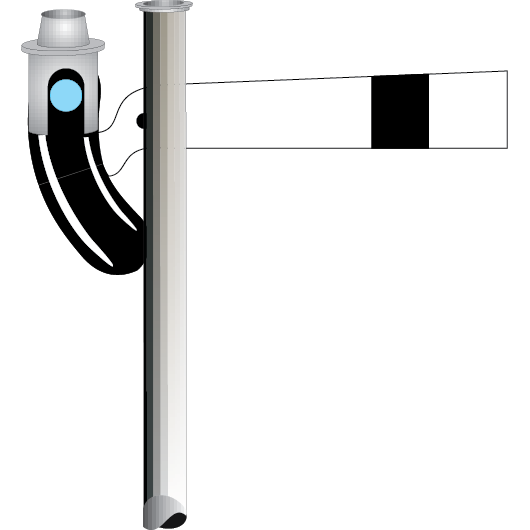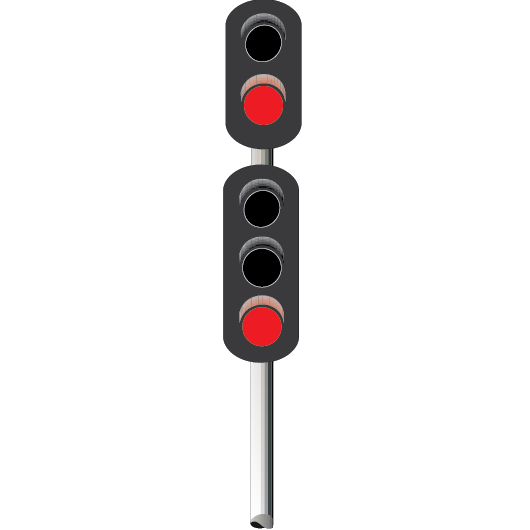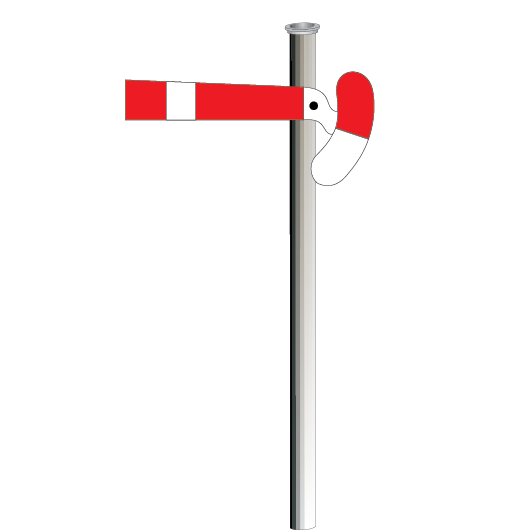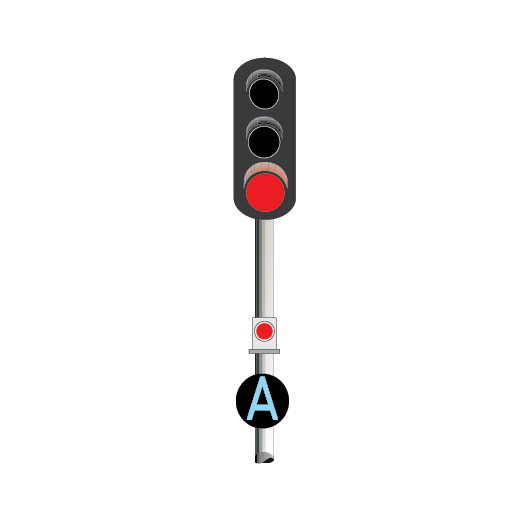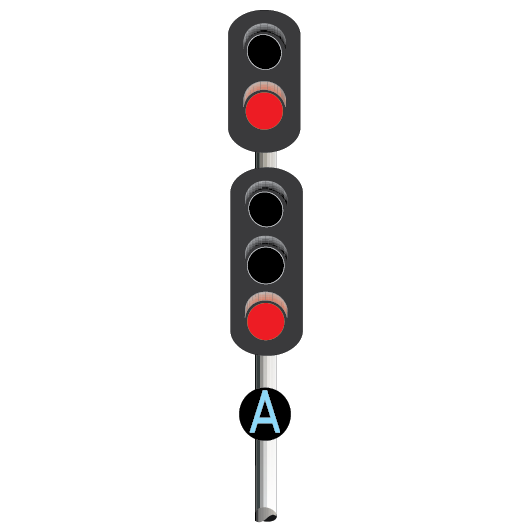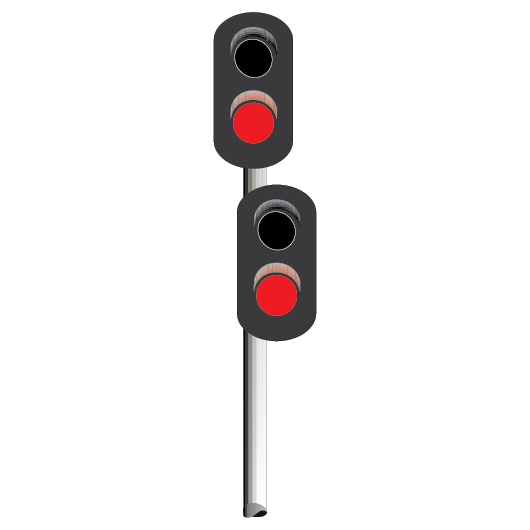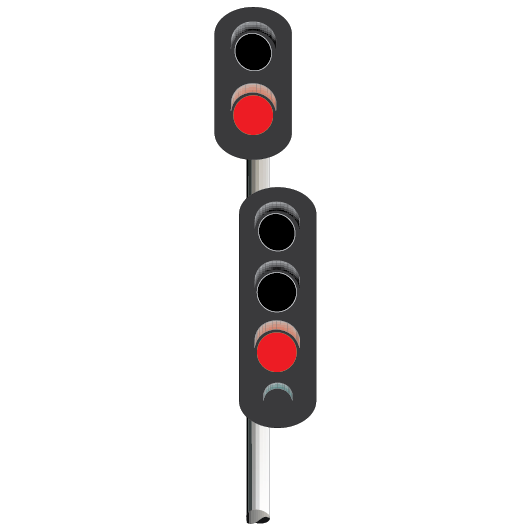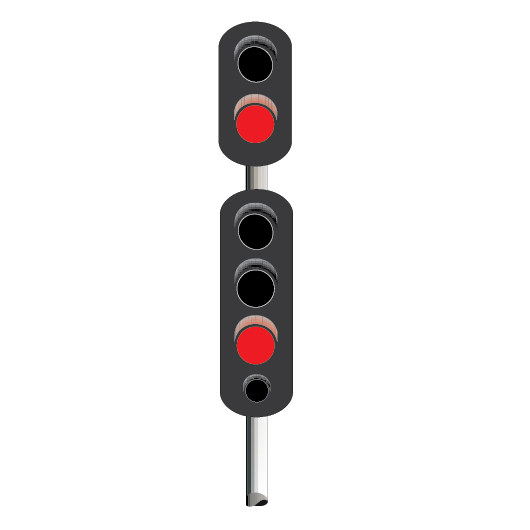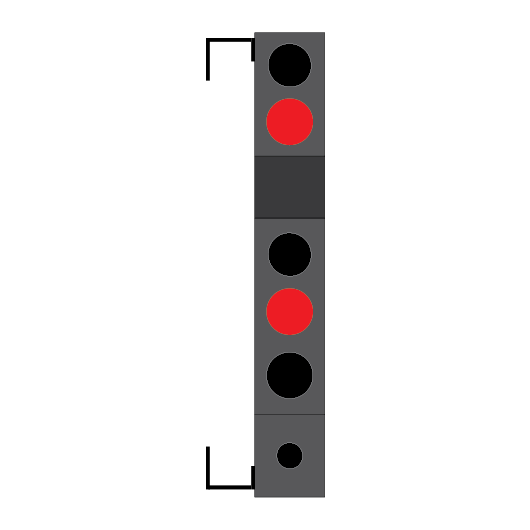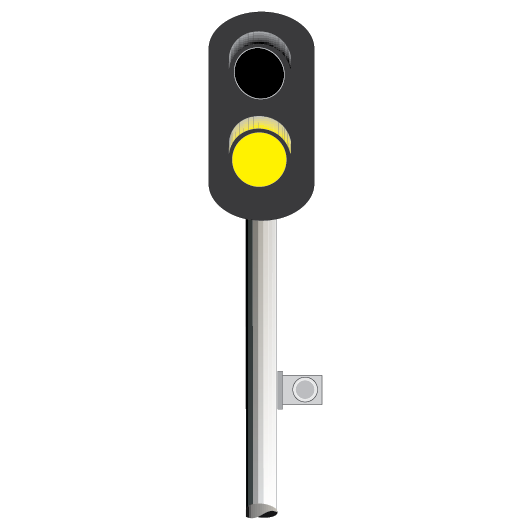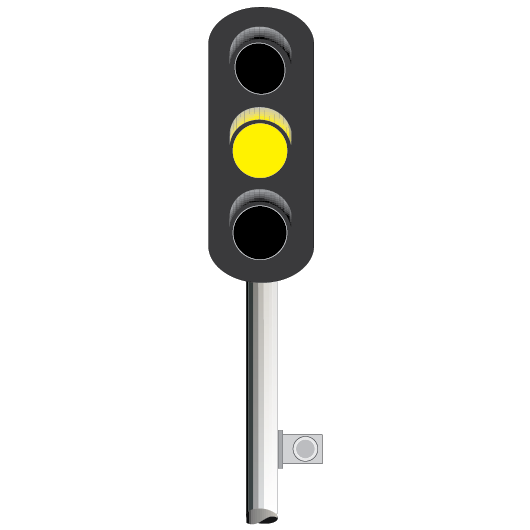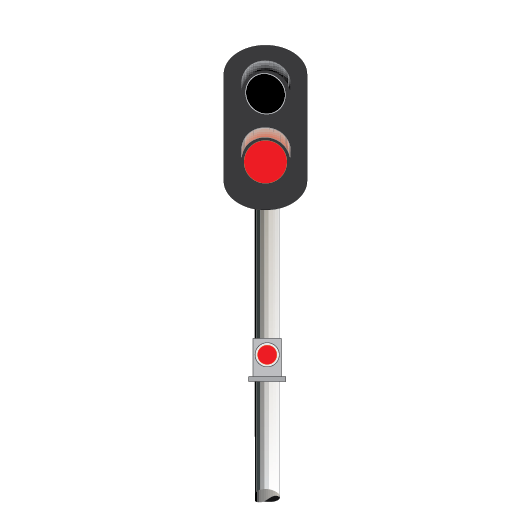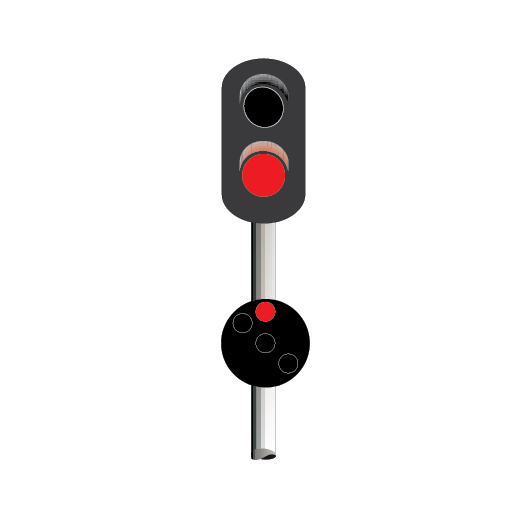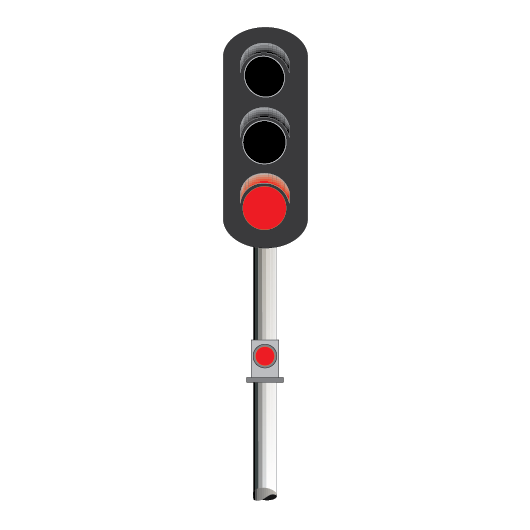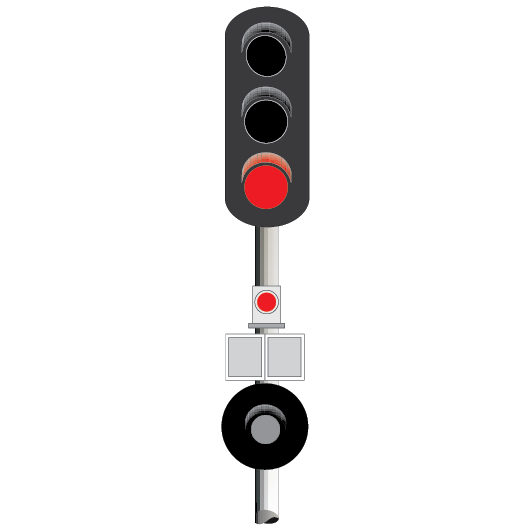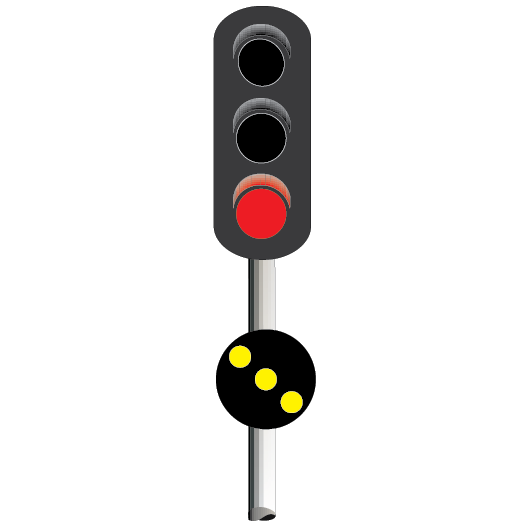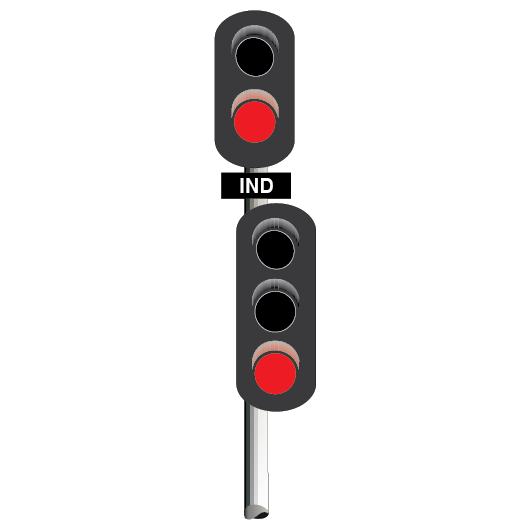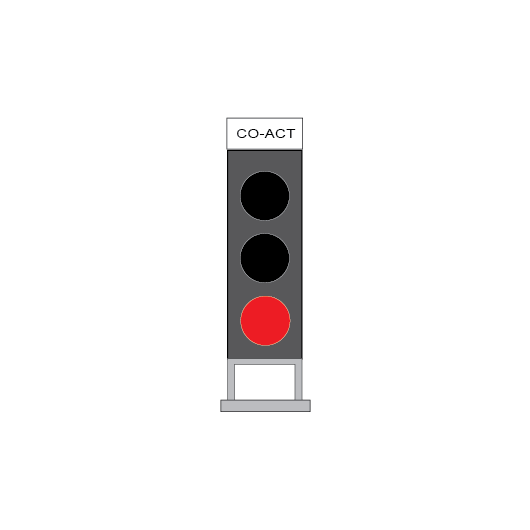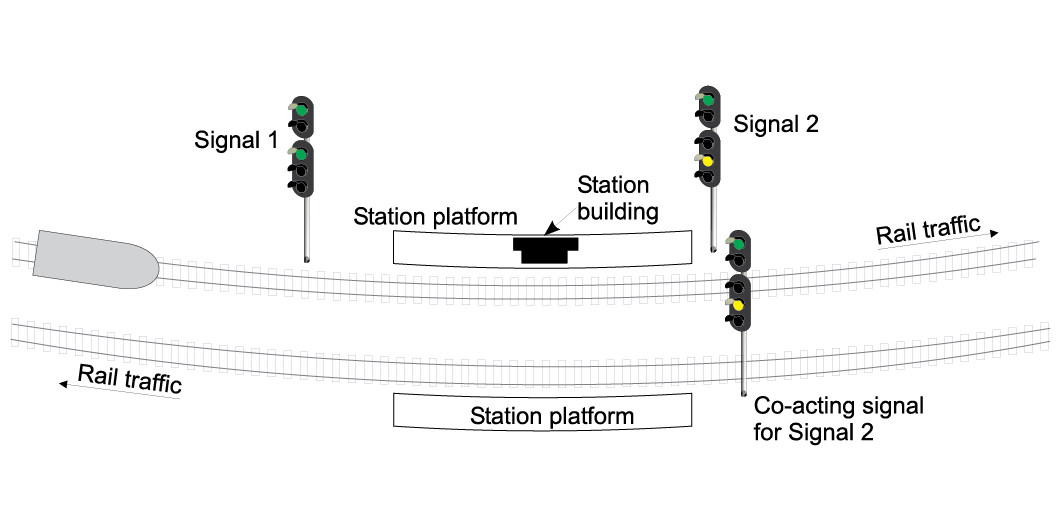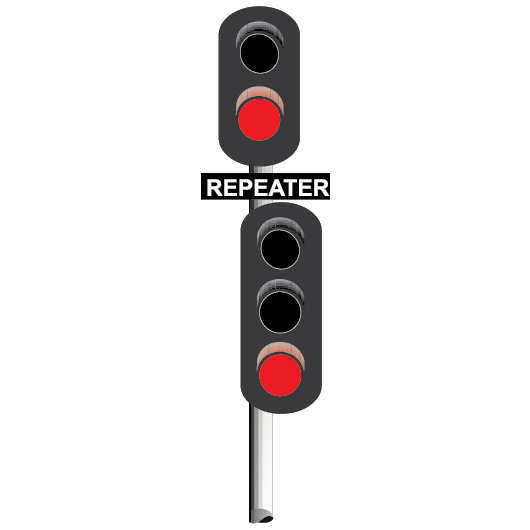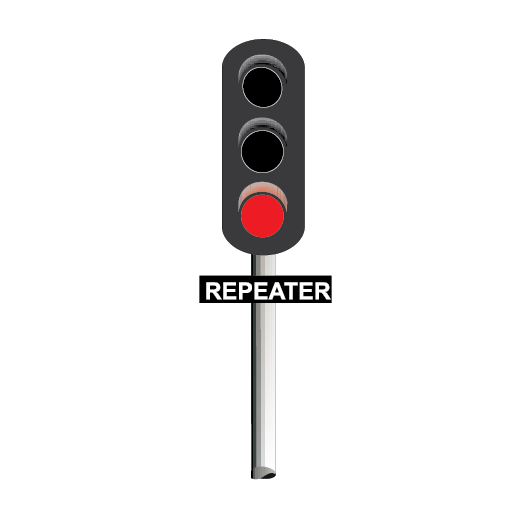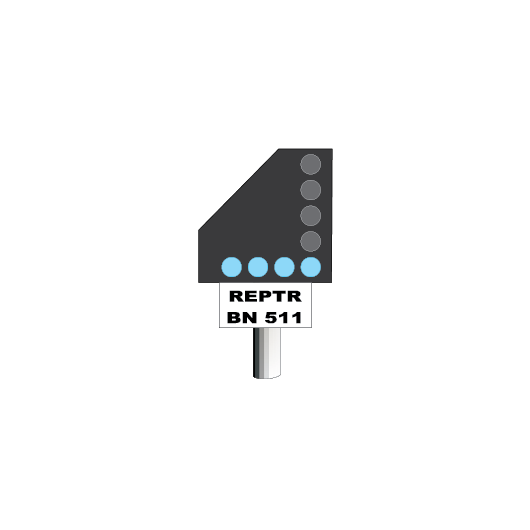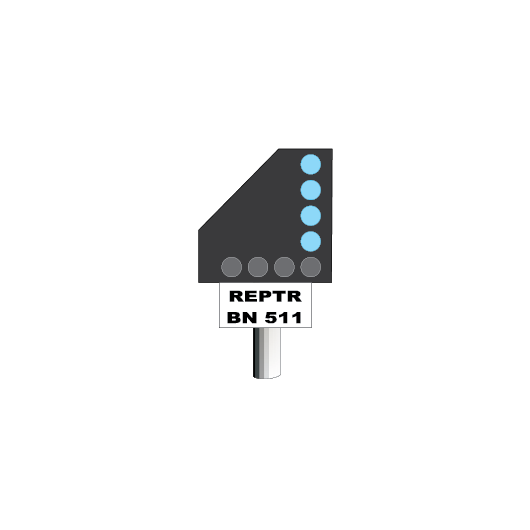Description
This document describes the types of running signals.
Not what you are looking for? See more NSG Rules
Purpose
To describe the types of running signals used in the Network.
Principle
Running signals are used to authorise through‑movements from one running signal to the next.
Running signals may be passed only in accordance with:
The Figures in this Rule show examples of the running signals used in the Network.
Route signalling
Running signals provide information about the route for which a signal is cleared.
Colour light running signals
In colour light signalled territory, a cleared signal indicates the route immediately beyond the signal by:
- the combination of lights displayed
- a route indicator
- a lower turnout unit.
Colour light signals
Colour light signals display singly or in combinations of red, yellow and green.
In the Figures, white or lunar white lights are shown in blue ![]() .
.
Semaphore signals
The front face of a semaphore running signal arm is red, with a transverse (across the arm) white stripe. The back face is white with a transverse black stripe.
The signal arm of fixed STOP semaphore signals may be reflective.
Semaphore signals that can be cleared have arms with red and green glass panels that are lit from behind at night.
Lower quadrant semaphore signals
Lower quadrant semaphore running signals have large arms to control main line movements.
Lower quadrant semaphore running signals have a back light to show that the lamp is lit and the signal is set at NORMAL.
Lower quadrant semaphore signals with square‑ended arms are home, outer home, starting, or home/starting signals.
Signal designations
Running signals, except for distant signals that cannot show STOP, are used to protect the block ahead.
Running signals are designated according to their purposes.
| Operation | Designation | Description |
|---|---|---|
| Controlled | Outer home or accept | Used to control entry to the block ahead, but not otherwise protect points or other identified risks. |
| Home | Used to protect points and other identified risks. Some home signals are kept permanently at STOP. | |
| Starting | Used to authorise departure from a controlled area. | |
| Home/starting | Functions as home and starting signal. | |
| Distant | Usually shows only CLEAR or CAUTION and cannot be used to protect the portion of line to the next signal. Some controlled distant signals can show STOP and can be used to protect the portion of line to the next signal. | |
| Automatic | Automatic | Protects the block ahead. Displays a PROCEED indication only if the block ahead is unoccupied |
| Distant | Usually shows only CLEAR or CAUTION and does not protect the portion of line to the next signal. Some automatic distant signals can show STOP and can be used to protect the portion of line to the next signal |
Running signal operation
Controlled signals
Controlled signals, other than distant signals, can be set and kept at STOP.
Controlled signals are operated by:
- signalling equipment controlled by Signallers, or
- a combination of track‑circuits, or axle counters, and signalling equipment controlled by Signallers.
Controlled signals can display a PROCEED indication only if:
- points in the route are in the correct position
- there are no conflicting routes set
- in Rail Vehicle Detection territory, the block ahead is unoccupied.
Controlled signals at attended locations are absolute signals.
| Type | Controlled operation status identified by |
|---|---|
| Double light colour light signal | Vertical lights. If an A sign or illuminated A light is on or near the signal, the operation mode is automatic. |
| Single light colour light signal | Marker light vertically below main signal lights. If an A sign or illuminated A light is on or near the signal, the operation mode is automatic. |
| Lower quadrant semaphore signal | Lower quadrant signals are controlled signals. |
Automatic signals
Automatic signals are controlled exclusively by the operation of track-circuits.
An automatic signal displays a PROCEED indication only if the line is unoccupied as far as the overlap point beyond the next signal.
Automatic signals are permissive signals. They can become absolute signals if they:
- are so designated by an instruction sign, or
- are interlocked with trackside monitoring equipment that sets them at STOP, or
- can be switched between automatic and controlled operation.
| Type | Automatic operation status identified by |
|---|---|
| Double light colour light signal | Staggered lights, or vertical lights with an A sign or illuminated A light on or near the signal. |
| Single light colour light signal | Marker light staggered below main signal lights; marker light vertically below main signal lights with an A sign or illuminated A light on or near the signal. |
| Lower quadrant semaphore signal | There are no lower quadrant automatic signals. |
A lights and A signs
In Rail Vehicle Detection territory only, some signals may be fitted with an A light or an A sign.
An A light can be fitted:
- on the post below a signal, or
- on or near a tunnel‑type signal.
If an A light is not lit, the signal is a controlled signal.
If the A light is lit, or the signal has an A sign on or near the signal, the signal:
- operates automatically
- is designated as an automatic signal.
Double light colour light signals with staggered lights
Double light colour light signals with staggered lamp cases are:
- automatic signals, or
- distant signals.
Double light colour light signals with vertical lights
Double light colour light signals with vertical in‑line lamp cases are:
- controlled signals, or
- automatic signals, if an A sign is fitted or an A light is lit.
Single light colour light signals with staggered marker light
Single light colour light signals with a staggered marker light are:
- automatic signals, or
- distant signals.
Automatic signals
Automatic single light colour light signals have a red marker light.
The marker light is lit if:
- the signal is at STOP, or
- the main light fails.
Distant signals
Single light colour light distant signals have a yellow marker light that is lit if the main light fails.
Some distant signals indicate STOP if the line between the distant signal and the next signal is occupied.
Distant signals may have a signal identification sign with the same signal identification as the signal ahead. The identification sign includes the word DISTANT.
Single light colour light signals with in-line marker light
Single light colour light signals with an in‑line red marker light are:
- controlled signals, or
- automatic signals, if an A sign or an A light is lit.
The marker light is lit if:
- the signal is at STOP, or
- the main light fails.
Lower turnout units
A PROCEED indication for a turnout route is displayed by a diagonal row of yellow lights on the turnout unit.
The row of lights is angled up towards the turnout route.
Co‑acting signals
If it is possible for a running signal to be obscured from a Driver’s or Track Vehicle Operator’s view, a co-acting signal may be used to provide information about the running signal indication.
Co-acting signals may have:
- a sign showing CO‑ACTING, INDICATOR, or an abbreviation
- a signal identification sign with the same details as those on the primary signal.
Repeater signals
An intermediate signal, known as a repeater signal, may be provided at some locations to give Drivers and Track Vehicle Operators better information about the indication of the next signal.
Repeater signals may or may not:
- be of the same appearance as the ordinary signals, or
- display the same types of indications.
A repeater signal may have a sign with the word REPEATER or some abbreviation. The repeater signal may display the same identification number as the next signal.
Colour light repeater signals display STOP if the line between the repeater signal and the next signal is occupied.
A repeater signal will not necessarily display the actual indication of the next signal, as its purpose is to give early information about that indication.
LED repeater signals
Light‑emitting diode (LED) repeater signals display four white lights.
Position light repeater signals
Position light repeater signals display two white lights.

